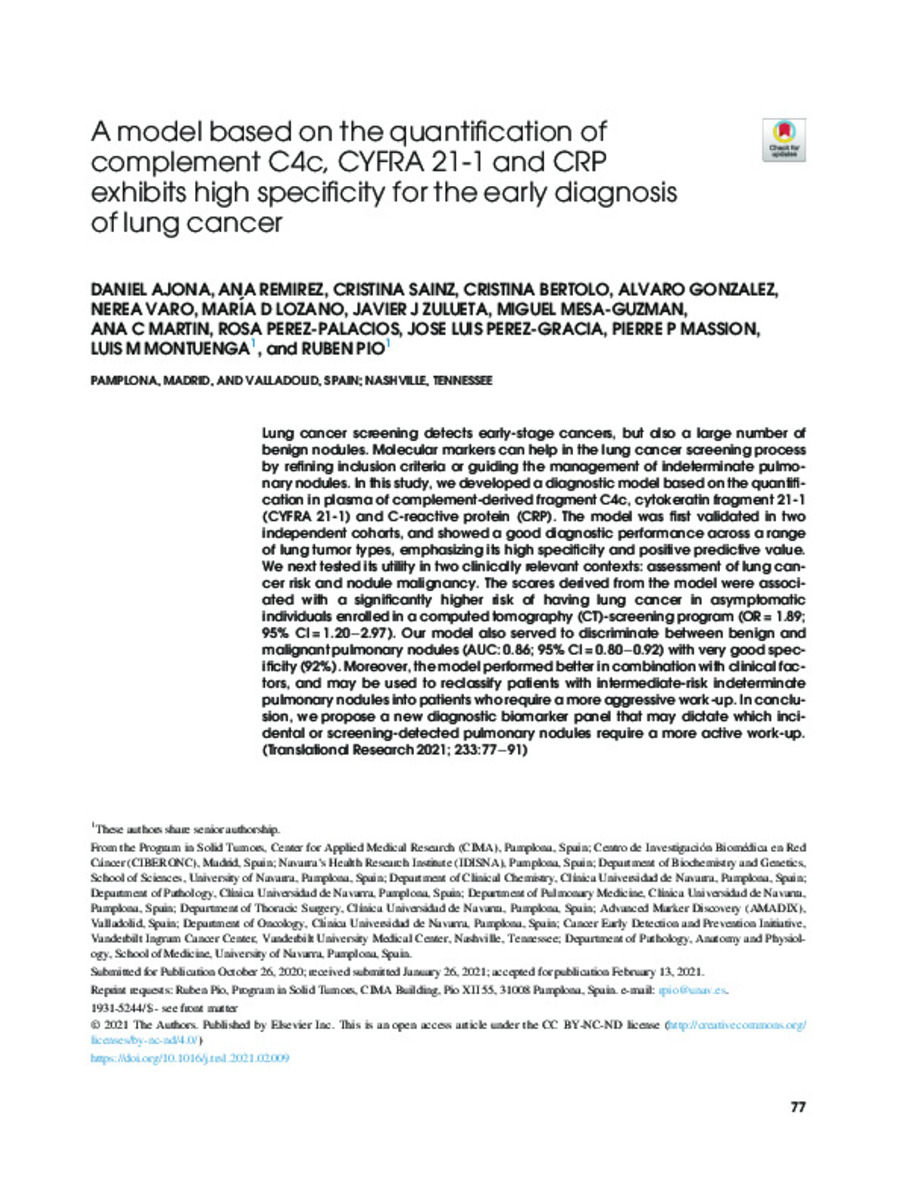Full metadata record
| DC Field | Value | Language |
|---|---|---|
| dc.creator | Ajona, D. (Daniel) | - |
| dc.creator | Remirez, A. (Ana) | - |
| dc.creator | Sainz, C. (Cristina) | - |
| dc.creator | Bertolo, C. (Cristina) | - |
| dc.creator | González, Á. (Álvaro) | - |
| dc.creator | Varo-Cenarruzabeitia, M.N. (Miren Nerea) | - |
| dc.creator | Lozano, M.D. (María Dolores) | - |
| dc.creator | Zulueta, J. (Javier) | - |
| dc.creator | Mesa-Guzmán, M.A. (Miguel Alejandro) | - |
| dc.creator | Martin, A.C. (Ana C.) | - |
| dc.creator | Perez-Palacios, R. (Rosa) | - |
| dc.creator | Perez-Gracia, J.L. (Jose Luis) | - |
| dc.creator | Massion, P.P. (Pierre P.) | - |
| dc.creator | Montuenga-Badia, L.M. (Luis M.) | - |
| dc.creator | Pio, R. (Rubén) | - |
| dc.date.accessioned | 2022-04-25T09:58:20Z | - |
| dc.date.available | 2022-04-25T09:58:20Z | - |
| dc.date.issued | 2021 | - |
| dc.identifier.citation | Ajona, D. (Daniel); Remirez, A. (Ana); Sainz, C. (Cristina); et al. "A model based on the quantification of complement C4c, CYFRA 21-1 and CRP exhibits high specificity for the early diagnosis of lung cancer". Translational Research. (233), 2021, 77 - 91 | es_ES |
| dc.identifier.issn | 1931-5244 | - |
| dc.identifier.uri | https://hdl.handle.net/10171/63410 | - |
| dc.description.abstract | Lung cancer screening detects early-stage cancers, but also a large number of benign nodules. Molecular markers can help in the lung cancer screening process by refining inclusion criteria or guiding the management of indeterminate pulmonary nodules. In this study, we developed a diagnostic model based on the quantification in plasma of complement-derived fragment C4c, cytokeratin fragment 21-1 (CYFRA 21-1) and C-reactive protein (CRP). The model was first validated in two independent cohorts, and showed a good diagnostic performance across a range of lung tumor types, emphasizing its high specificity and positive predictive value. We next tested its utility in two clinically relevant contexts: assessment of lung cancer risk and nodule malignancy. The scores derived from the model were associated with a significantly higher risk of having lung cancer in asymptomatic individuals enrolled in a computed tomography (CT)-screening program (OR = 1.89; 95% CI = 1.20–2.97). Our model also served to discriminate between benign and malignant pulmonary nodules (AUC: 0.86; 95% CI = 0.80–0.92) with very good specificity (92%). Moreover, the model performed better in combination with clinical factors, and may be used to reclassify patients with intermediate-risk indeterminate pulmonary nodules into patients who require a more aggressive work-up. In conclusion, we propose a new diagnostic biomarker panel that may dictate which incidental or screening-detected pulmonary nodules require a more active work-up. | es_ES |
| dc.description.sponsorship | This study was supported by Foundation for Applied Medical Research (FIMA), Centro de Investigación Biomédica en Red Cáncer (CIBER-ONC), Fundación Científica de la Asociación Española Contra el Cáncer, Fundación Ramón Areces, Juan Serrano, Instituto de Salud Carlos III-EU FEDER “Una manera de hacer Europa” (PI17/00411, PI19/00098, PI20/00419), Amadix, and National Cancer Institute (NCI CA152662). | es_ES |
| dc.language.iso | eng | es_ES |
| dc.publisher | Elsevier | es_ES |
| dc.rights | info:eu-repo/semantics/openAccess | es_ES |
| dc.subject | Lung cancer | es_ES |
| dc.subject | Pulmonary nodules | es_ES |
| dc.subject | Cytokeratin | es_ES |
| dc.subject | Computed tomography | es_ES |
| dc.title | A model based on the quantification of complement C4c, CYFRA 21-1 and CRP exhibits high specificity for the early diagnosis of lung cancer | es_ES |
| dc.type | info:eu-repo/semantics/article | es_ES |
| dc.description.note | This is an open access article under the CC BY-NC-ND license | es_ES |
| dc.identifier.doi | 10.1016/j.trsl.2021.02.009 | - |
| dadun.citation.endingPage | 91 | es_ES |
| dadun.citation.number | 233 | es_ES |
| dadun.citation.publicationName | Translational Research | es_ES |
| dadun.citation.startingPage | 77 | es_ES |
Files in This Item:
Statistics and impact
Items in Dadun are protected by copyright, with all rights reserved, unless otherwise indicated.






